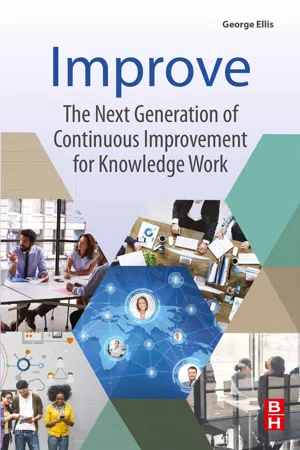
- 500 pages
- English
- ePUB (mobile friendly)
- Available on iOS & Android
About this book
Improve: The Next Generation of Continuous Improvement for Knowledge Work presents lean thinking for professionals, those who Peter Drucker called knowledge workers. It translates the brilliant insights from Toyota's factory floor to the desktops of engineers, marketers, attorneys, accountants, doctors, managers, and all those who "think for a living." The Toyota Production System (TPS) was born a century ago to an almost unknown car maker who today is credited with starting the third wave of the Industrial Revolution. TPS principles, better known as lean thinking or continuous improvement, are simple: increase customer value, cut hidden waste, experiment to learn, and respect others. As simple as they are, they are difficult to apply to the professions, probably because of the misconception that knowledge work is wholly non-repetitive. But much of our everyday work does repeat, and in great volume: approvals, problem-solving, project management, hiring, and prioritization are places where huge waste hides. Eliminate waste and you delight customers and clients, increase financial performance, and grow professional job satisfaction, because less waste means more success and more time for expertise and creativity.This book is a valuable resource for leaders of professional teams who want to improve productivity, quality, and engagement in their organizations.- Experience the proven benefits of continuous improvement- 40%–70% increase in productivity from professionals and experts- >85% projects on-time- Reduce lead time by 50%–90%- Engagement up and voluntary severance cut >50%- Dozens of simple visual tools that anyone can implement immediately in their existing framework- All tools and techniques applicable to both face-to-face and virtual meetings- Easy-to-understand approach: "simplify, engage, experiment- Presented with deep respect for the experts; no "check the box thinking or overused analogies to the factory floor
Frequently asked questions
- Essential is ideal for learners and professionals who enjoy exploring a wide range of subjects. Access the Essential Library with 800,000+ trusted titles and best-sellers across business, personal growth, and the humanities. Includes unlimited reading time and Standard Read Aloud voice.
- Complete: Perfect for advanced learners and researchers needing full, unrestricted access. Unlock 1.4M+ books across hundreds of subjects, including academic and specialized titles. The Complete Plan also includes advanced features like Premium Read Aloud and Research Assistant.
Please note we cannot support devices running on iOS 13 and Android 7 or earlier. Learn more about using the app.
Information
30% of what you think is wrong
Abstract
Keywords
1.1 A good story
- At the start, a team of good people trying to do the right thing is stumbling: they are often late, make too many mistakes, and frequently focus on the wrong things. This happens even though they are smart, experienced, and hardworking.
- Their transformation begins as we search for hidden waste in their workflows. The brilliant insight of lean thinking is that waste is always there in abundant quantities, most of it hiding in plain sight. The core of what professionals and experts do—what we will call knowledge work—is complex, even mysterious, but most of the waste it creates is tedious and predictable.
- Next, we install a few techniques carefully targeted at real problems. These techniques are a combination of: simplify to cut the waste we see, engage the full team, and experiment continuously to find waste that's hiding in plain sight. A new visualization method. A regular team standup meeting. An unambiguous call to action. A “Single Point of Truth” to give everyone the same information. Quantifying success and then laying out a path to it. Defining the problem thoroughly before starting to solve it. Always simplifying. Always engaging. Always experimenting.
- A few months later, that team is outperforming its initial level by a margin so wide it's noticed by colleagues, the boss, a few customers, and probably some family members. People in the team smile more and walk taller. At first, many stood back waiting to see results before they bought in. Now almost all are convinced that they can improve, and they want to.
1.1.1 Dangerous assumptions
- • This is how we've always done it and it works fine.
- • Someone I trust told me, so I don't need to see it myself.
- • It seems logical, so it probably works.
- • It's not working because other people are not trying hard enough.
1.1.2 The dilemma of lean knowledge
Table of contents
- Cover image
- Title page
- Table of Contents
- Copyright
- Foreword
- Endorsements
- Preface
- Acknowledgments
- Chapter 1: 30% of what you think is wrong
- Chapter 2: A brilliant insight
- Chapter 3: Creating value from knowledge work
- Chapter 4: The lean equation
- Chapter 5: DIMINISH: Recognizing the 8 Wastes of Knowledge Work
- Chapter 6: Simplify, engage, and experiment
- Chapter 7: Reduce Waste #1: Discord
- Chapter 8: Reduce Waste #2: Information Friction
- Chapter 9: Reduce Waste #3: More-is-Better Thinking
- Chapter 10: Reduce Waste #4: Inertia to Change
- Chapter 11: Reduce Waste #5: No-Win Contests
- Chapter 12: Reduce Waste #6: Inferior Problem Solving
- Chapter 13: Reduce Waste #7: Solution Blindness
- Chapter 14: Reduce Waste #8: Hidden Errors
- Chapter 15: Standardize workflow
- Chapter 16: Workflow improvement cycle
- Chapter 17: Workflow—Checklists and expert rule sets
- Chapter 18: Workflow—Problem Solve-Select
- Chapter 19: Workflow—Visual management for initiatives and projects
- Chapter 20: Workflow—Visual management with buffer
- Chapter 21: Workflow—Kanban and Kamishibai: Just-In-Time Rationalization
- Chapter 22: Workflow—Putting out “fires”
- Chapter 23: Workflow—Visualizing revenue gaps
- Chapter 24: Workflow—Leadership review of knowledge work
- Index